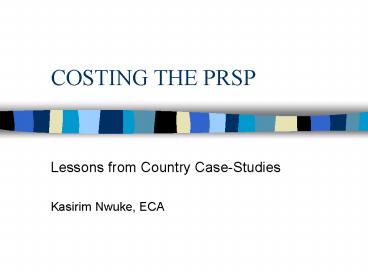COSTING THE PRSP - PowerPoint PPT Presentation
1 / 11
Title: COSTING THE PRSP
1
COSTING THE PRSP
- Lessons from Country Case-Studies
- Kasirim Nwuke, ECA
2
Background
- ECA commissioned ten country studies
- Ethiopia, Kenya,
- Zambia, Malawi,
- Rwanda, Ghana,
- Sierra-Leone, Burkina Faso,
- Cote dIvoire, Senegal
3
Objectives of the Studies
- To assess the experience of a sub-set Africa PRSP
countries with respect to preparing or
implementing the PRSP - On Content of the PRSP- To examine whether the
growth strategies are pro-poor and the degree to
which the social sector, especially health
(HIV/AIDS), education are reflected in the PRSP - On Financing of the PRSP To examine whether the
PRSP is costed, its link with the MTEF, sources
of financing it - To assess whether capacity requirements for a
successful implementation were duely considered - To assess the degree to which donors were
beginning to harmonize their policies and
programs with the countrys PRSP.
4
Ghana
- Costing of the PRSP is an issue
- The GoG appears not to have a coherent strategy
on how it will pay for its programs - Financing sources are public sector driven and
will require greater domestic revenue
mobilization effort. - An effective and efficient public sector is
required to meet these objectives. But Ghana is
far from having this. - Costing of policy options remains a difficult
task and where it has been done, quality varies
from sector to sector - Implementation of the PRSP is therefore likely to
be hampered as a consequence.
5
Zambia
- Estimates of financing resources based on
projected domestic resources - The underlying assumption of the estimates is a
4.1 annual growth rate during the period - The 17 sectors of activities identified are
costed The total cost is 1.2 bln (down from
the initial 4 bln) - Only core priority activities are included in the
current PRSP others postponed to later PRSPs. - Financing Sources
- Tax revenues 18.5 0f GDP
- Non-tax revenues 0.4 of GDP
- External Assistance (project/programme grants)
5.3 of GDP - Deficit financing 3 of GDP
- Financing Gap 2.3 (95 mln in 2003), 1.6 (72
mln in 2004) expected to be financed by donors. - Lessons Projects were ranked and final cost
arrived at through an iterative process.
6
Kenya
- There is no evidence that the PRSP was adequately
costed - The financing gap is so wide (Kshs 70 bln) that
it is considered a wish-list - Bids are not appraised against available
resources (weak priority-setting) - There is no mechanism for balancing priorities
with affordability - Donors have reacted by asking the GoK to prepare
an Action, GAP, outlining how it intends to
implement the PRSP.
7
Sierra Leone
- Sierra Leone does not yet have a F-PRSP
- There is no evidence that the I-PRSP was costed
- Most of the financing for the I-PRSP came from
external sources - Projected financing requirements of the F-PRSP
now being finalized 391 million (2002) and 337
million (2003) - Financing gap 89 million (2002) 76 million
(2003) - The gap is expected to be financed by external
partners.
8
Malawi
- The PRSP was costed according to three
categories Statutory (interest payments,
pensions, gratuities), Statehood (defence, govt
services), Poverty reduction - Basis of costing targets and unit costs
priority-ranking (limited to the GoM sector) - The scope for costing was limited by
- Capacity constraints
- Poor assimilation and internalization of costing
guidelines and methodologies - Lack of will to make hard decisions
- Inadequate consultations
- Overall, an attempt was made to establish
realistic estimates of cost.
9
Ethiopia
- Initial estimated total cost of the program is
52.5 billion ETB for the period 02/03 04/05 - This has been revised downward in view of the
magnitude of the resource gap that emerged to 37
bln ETB. - Revision based on re-proritization of programs
and activities - Financing sources reduction in defense
expenditures increased domestic mobilization
cuts in administrative and government services
moderate external support. - Domestic financing likely to be a problem because
of low tax base, fragile growth foundations, etc.
10
Some Lessons
- Countries are struggling with the problem of
costing their PRSP. Some (e.g. Kenya) have not
done so the PRSP - Those (Zambia, Ethiopia) that have attempted to
cost the program have done so iteratively - It appears that this was not done systematically
the emergence of a large resource gap appears to
be the impetus for downward revisions in
estimated financing needs - The domestic resource mobilization assumptions
are weak and the goals of increased domestic
revenue mobilization unlikely to be met
11
Some (Tentative) Conclusions
- The weak domestic resource base implies enhanced
scope for donor support and perhaps for donor
conditionalities - Progress towards poverty reduction is unlikely as
a consequence to be fairly rapid - If PRSs are to be indeed country-driven and
country-owned, they must be realistically costed,
projects must be duely ranked and the ranking
then should influence the content of the PRSP
itself - The costing problems arise either as an incentive
problem (the amount of debt relief) or a capacity
problem (countries lack costing capacity) or
both.

